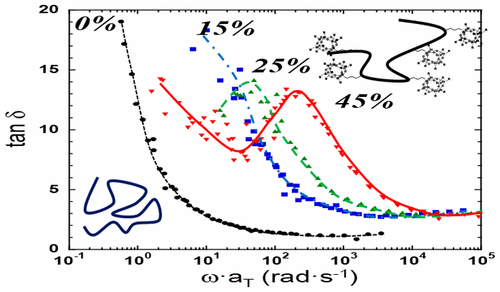当前位置:
X-MOL 学术
›
Macromolecules
›
论文详情
Our official English website, www.x-mol.net, welcomes your
feedback! (Note: you will need to create a separate account there.)
Viscoelastic Behavior of Unentangled POSS–Styrene Nanocomposites and the Modification of Macromolecular Dynamics
Macromolecules ( IF 5.1 ) Pub Date : 2017-09-08 00:00:00 , DOI: 10.1021/acs.macromol.7b01645 Angel Romo-Uribe 1
Macromolecules ( IF 5.1 ) Pub Date : 2017-09-08 00:00:00 , DOI: 10.1021/acs.macromol.7b01645 Angel Romo-Uribe 1
Affiliation

|
The viscoelastic properties of molten unentangled hybrid nanocomposites poly[(propylmethacryl-heptaisobutyl-POSS)-co-styrene], denoted POSS-sty, were investigated; POSS content varied up to 45 wt %. Unentangled polystyrene (PS) was also investigated. Differential scanning calorimetry (DSC) showed that the glass transition temperature, Tg, significantly decreased relative to neat PS, i.e., ΔTg < 0, and this effect was not associated with molecular weight. Master curves were constructed using the time–temperature superposition (TTS) principle. The shift factors obeyed Arrhenius-type relationship, and the calculated flow activation energy Ea first increased and then rapidly decreased as POSS content increased. The viscoelastic spectra of PS and the nanocomposites exhibited only the terminal regime (G′′ > G′), whereas PS exhibited the typical Rouse behavior; POSS-sty melts did not obey the scaling G′′ ∼ ω2. Strikingly, the mechanical damping tan δ exhibited minima at the longest relaxation time, not seen in melts of unentangled flexible polymers. This suggests (weak) interactions/associations between the bulky POSS groups giving rise to dynamics retardation. The fractional free volume fg exhibited considerable increase, and the zero-shear viscosity η0 decreased an order of magnitude, relative to the neat polymer. Analysis of several POSS-based nanocomposites showed that ΔTg was positive or negative, in all cases produced viscosity reduction, and molecular weight was not a factor. As entanglements effects were removed in this styudy, the results suggest a modified polymer dynamics driven by interactions/associations of the bulky POSS macromers, thus opening opportunities for tunability of bulk properties in nanocomposites and the development of advanced functional materials.
中文翻译:

未缠结的POSS-苯乙烯纳米复合材料的粘弹性行为和大分子动力学的修饰
研究了熔融无缠结的杂化纳米复合材料聚[(丙基甲基丙烯酸-庚二异丁基-POSS)-共-苯乙烯]的粘弹性,表示为POSS-sty。POSS含量变化高达45重量%。还研究了无缠结的聚苯乙烯(PS)。差示扫描量热法(DSC)显示,相对于纯PS,玻璃化转变温度T g显着降低,即ΔT g <0,并且该影响与分子量无关。主曲线是使用时温叠加(TTS)原理构建的。位移因子服从Arrhenius型关系,计算出的流动活化能E a随着POSS含量的增加,首先增加,然后迅速减少。PS和纳米复合材料的粘弹性谱仅表现出末端状态(G ''> G '),而PS表现出典型的Rouse行为。POSS麦粒肿熔体不听从缩放摹''〜ω 2。令人惊讶的是,机械阻尼tanδ在最长的弛豫时间表现出极小值,这在未缠结的挠性聚合物的熔体中没有看到。这表明庞大的POSS组之间的(弱)相互作用/关联会导致动力学延迟。的自由体积分数˚F克展出相当大的增加,零剪切粘度η 0相对于纯净的聚合物降低了一个数量级。对几种基于POSS的纳米复合材料的分析表明,ΔT g为正或负,在所有情况下都会导致粘度降低,并且分子量不是影响因素。由于在这种研究中消除了纠缠效应,结果表明,由庞大的POSS大分子单体的相互作用/缔合驱动了改性的聚合物动力学,从而为纳米复合材料的整体性质的可调性和先进功能材料的开发提供了机会。
更新日期:2017-09-08
中文翻译:

未缠结的POSS-苯乙烯纳米复合材料的粘弹性行为和大分子动力学的修饰
研究了熔融无缠结的杂化纳米复合材料聚[(丙基甲基丙烯酸-庚二异丁基-POSS)-共-苯乙烯]的粘弹性,表示为POSS-sty。POSS含量变化高达45重量%。还研究了无缠结的聚苯乙烯(PS)。差示扫描量热法(DSC)显示,相对于纯PS,玻璃化转变温度T g显着降低,即ΔT g <0,并且该影响与分子量无关。主曲线是使用时温叠加(TTS)原理构建的。位移因子服从Arrhenius型关系,计算出的流动活化能E a随着POSS含量的增加,首先增加,然后迅速减少。PS和纳米复合材料的粘弹性谱仅表现出末端状态(G ''> G '),而PS表现出典型的Rouse行为。POSS麦粒肿熔体不听从缩放摹''〜ω 2。令人惊讶的是,机械阻尼tanδ在最长的弛豫时间表现出极小值,这在未缠结的挠性聚合物的熔体中没有看到。这表明庞大的POSS组之间的(弱)相互作用/关联会导致动力学延迟。的自由体积分数˚F克展出相当大的增加,零剪切粘度η 0相对于纯净的聚合物降低了一个数量级。对几种基于POSS的纳米复合材料的分析表明,ΔT g为正或负,在所有情况下都会导致粘度降低,并且分子量不是影响因素。由于在这种研究中消除了纠缠效应,结果表明,由庞大的POSS大分子单体的相互作用/缔合驱动了改性的聚合物动力学,从而为纳米复合材料的整体性质的可调性和先进功能材料的开发提供了机会。











































 京公网安备 11010802027423号
京公网安备 11010802027423号